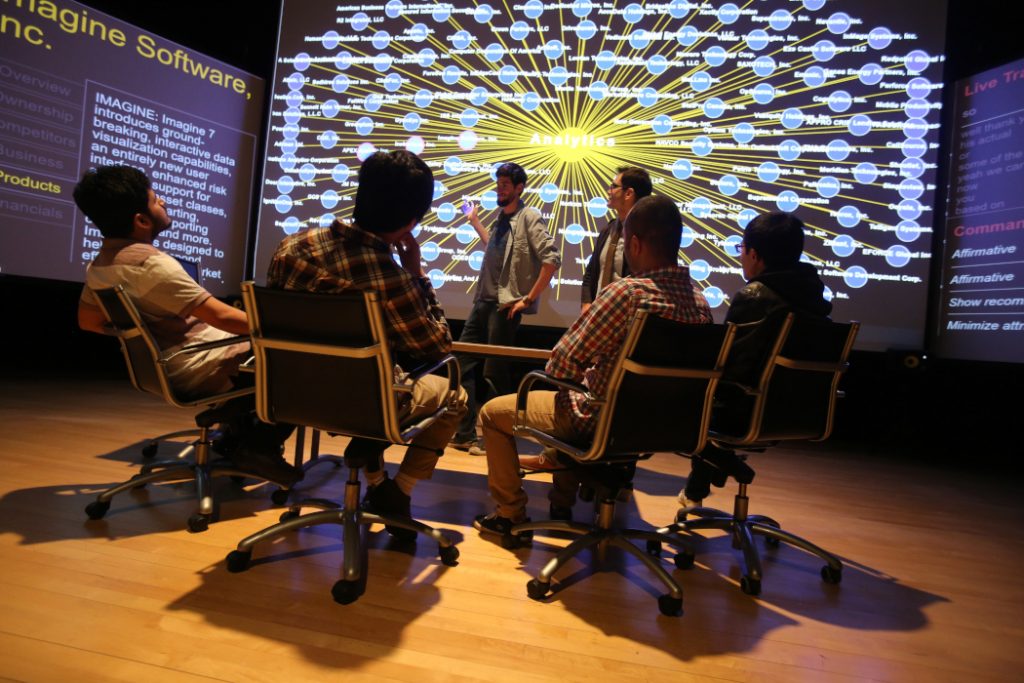This year, students and faculty researchers at one of the nation’s top engineering schools, Rensselaer Polytechnic Institute (RPI), in Troy NY, will be learning and leveraging cutting-edge recording and production techniques in an updated and reimagined media studio operated by RPI’s School of Humanities, Arts and Social Sciences (HASS). The flexible design of RPI’s new HASS Media Studio makes it a great space to not only create, mix and edit, but also digitally access RPI’s other performance and media-research spaces via the school’s network fiber infrastructure. As a result, projects in the new studio space promise to span schools and disciplines, while expanding the horizons of its varied users. According to Jeff Gazdacko, who will run the studio as its Senior Media Engineer, “The possibilities are really endless as a result of the studio’s tools, connectivity and, ultimately, flexible design.”
A Vision For Common Technology
With the continuing confluence of AVL and IT, institutions of higher learning must have an approach to these key technologies that is anything but traditional. Leaders in education must maintain a proactive vision for their media spaces, or they’ll face falling behind a fast-moving technology curve. Rapidly evolving network technology has become key in advancing the application of new digital protocols for audio and video. Those advancements continue to increase expectations of how AVL tools can be used in both education and research settings. Institutions invested in those pursuits can’t afford to be caught flat-footed, and they must commit to more than just a useful awareness of the trends and contours of professional production environments. According to the forward-thinking Dean of RPI’s School of Humanities, Arts and Social Sciences, Mary Simoni, PhD, bringing best-of-class technologies together and putting them within the reach of students and researchers is key to achieving the school’s research goals and the success of its students. “Educational institutions tend to have layers of policy aimed at helping to shape the pedagogy,” Simoni began, “but, with many diverse programs, policies can sometimes be at odds.” Occasionally, she said, a project comes along that can align with the requirements of multiple programs, bringing together technologies as well as groups of students and pedagogies.
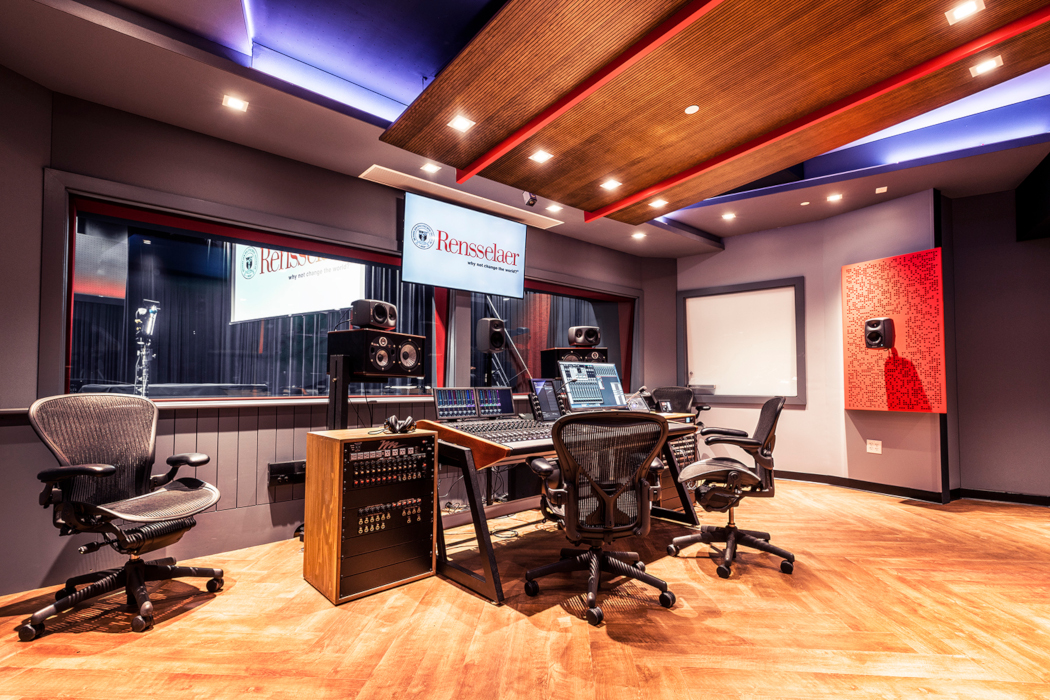
It was Simoni who spotted that potential in an underutilized broadcast studio and control room space located in the basement of RPI’s Darrin Communications Center (DCC). “We were looking for a space that could provide students with a high-end experience in a great acoustical space,” Simoni recalled. “That’s important for students on all levels and our faculty researchers.” The fact that the aging studio’s location in the basement of the DCC offered robust network connectivity to other campus facilities did not escape Simoni’s attention.
With access to broad connectivity provided by RPI’s existing network, including the ample bandwidth of dark fiber that runs across the campus, the possibility of converting an underpowered and underutilized studio space into a useful studio that could be a media hub connecting RPI’s considerable research and performance areas significantly raised the project’s profile.
Fiber Connectivity
Easy access to the school’s network of dark fiber introduced the possibility of connecting the new HASS Media Studio to four state-of-the-art performance venues on the RPI campus using Multichannel Audio Digital Interface (MADI) and Dante protocols. These larger and well-equipped spaces, housed at RPI’s Curtis R. Priem Experimental Media and Performing Arts Center (EMPAC), are designed to allow audiences, artists and researchers to interact and explore the ever-changing relationship between humans and technology.
RPI’s existing fiber infrastructure could also provide a digital pathway between the new studio and the Cognitive and Immersive Systems Lab (CISL), a collaboration between IBM Research and RPI. At the CISL, a Situations Room Infrastructure (SRI) enables multimodal group-computers dialogue, learning and understanding of group activities, reasoning, planning and facilitation of collaborative decision-making. Control of progressive media elements, like 360-degree projection and experiential surround-sound setups, is important to supporting cognitive research, as are basic production techniques for communicating and documenting findings.
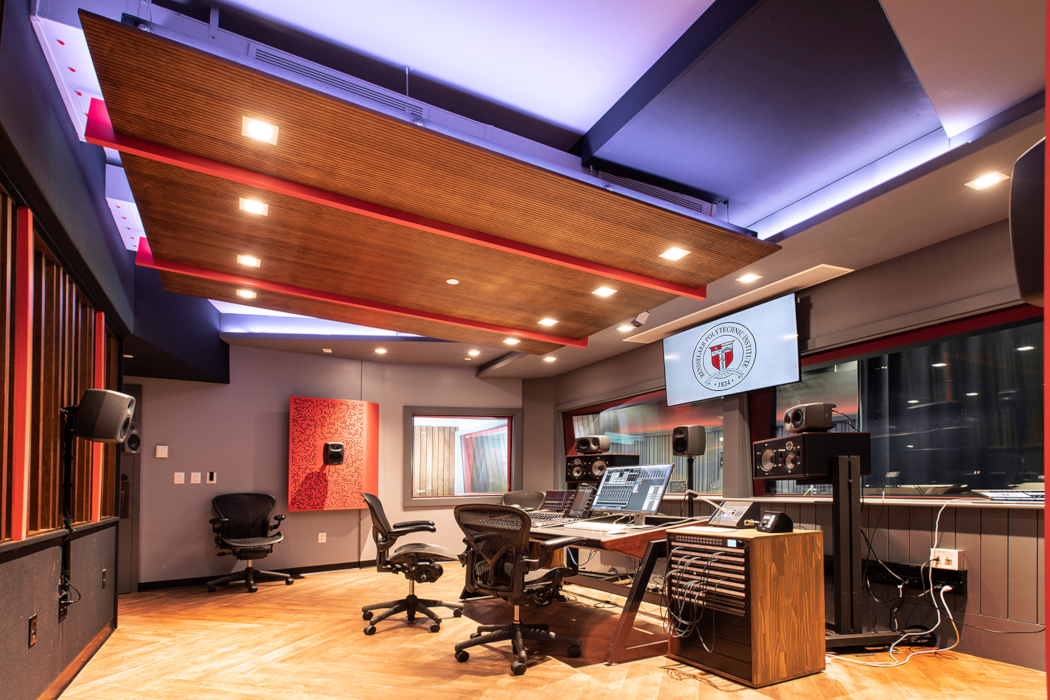
The impressive EMPAC rooms and the advanced projects at the CISL are important not only for research, but also because they are emblematic of RPI’s “New Polytechnic” paradigm for cross-disciplinary research and education, which spans the institute’s five schools and areas of computer science, cognitive science, computing systems and engineering, arts, media, communication and healthcare. A new studio equipped with the latest audio, video and networking technologies, implemented via low-latency digital fiber pathways, could bring them closer together. “We saw at once how the new studio could be an advantage for the school, and [we saw] its vast potential,” Simoni affirmed. “My role was to ‘sell’ the vision to the school’s administration and potential donors.”
Flexible Design
Simoni reached out to Walters-Storyk Design Group (WSDG), based in Highland NY, to investigate further and to provide technical assistance for the project. In response to Simoni’s challenge to redesign and equip the space, WSDG’s John Storyk, Joshua Morris and Kevin Peterson completed a baseline acoustic study and studio feasibility study. After the proof of concept was done, Judy Elliot-Brown, AV Systems Designer with WSDG, stepped in when design had begun in earnest.
When Elliot-Brown toured the existing studio and control room space, she took measurements and noted details about the space. However, in addition, she arranged for conversations with RPI’s AV technicians, IT department, faculty, administration and student representatives to understand more fully how the existing space was being used; she also sought to get information about each group’s needs as regards media mixing, editing and teaching. Elliot-Brown also devoted hours of research to understanding how the different groups worked.
“We asked many questions,” Elliot-Brown said, “including how other equipment and spaces around the campus were used, what equipment had been specified and why.” With credits in audio design since 1977, experience has shown her that creators and engineers are at their best when they are comfortable, and that the designs that work best have considered the fact that everyone has a different way of working. “These spaces are used for creating, so it is important that tools and spaces are designed so that users don’t have to think about the technology,” Elliot-Brown declared.
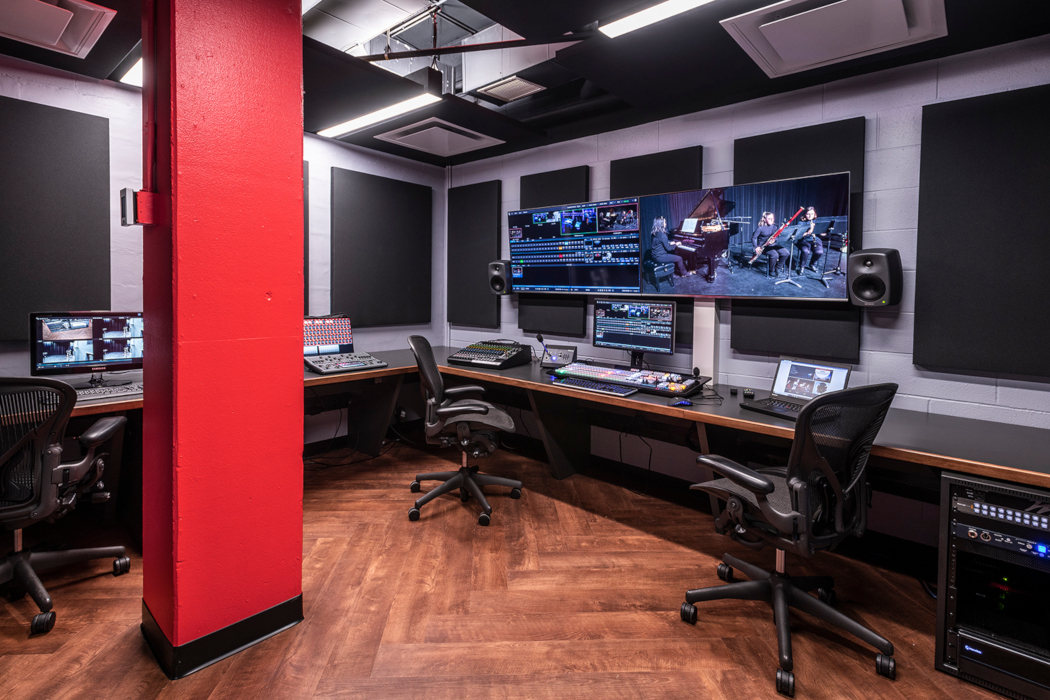
WSDG presented the project to Simoni and her team in CAD renderings, construction plans and auralization demonstrations with CATT-Acoustics software that detailed the different equipment strategies, acoustical treatments and design recommendations for the new facility. Hearing sample .wav files helped confirm the direction of the design for Simoni before she made her presentation to the administration.
WSDG’s approved design for the new HASS Media Studio called for the complete renovation of the existing 1,700-square-foot space, as well as the design, construction supervision and AV integration of a 1,000-square-foot audio recording and production studio, a cutting-edge 300-squarefoot audio control room, a 100-square-foot isolation booth, 160-square-foot video control room and a 90-square-foot AV lab. The new design would maintain the existing 16-foot ceiling height, lighting grid and basic shape of the original production studio, with slight changes in the size of the isolation booth.
Improved Production Space
Morris, WSDG’s Project Manager for the HASS Media Studio, worked closely with RPI’s Manager of Operations and Administrative Services, Kim Osburn, and RPI’s Project Manager for Campus Planning and Facilities Design, Robert Carney, to schedule demolition and construction work to complete the redesign and address the acoustic challenges of the new space.
A major improvement for the 1,000-square-foot production space was realized with better acoustical treatment. “The existing studio walls had been treated liberally with one-inch fiberglass, making the space less appropriate for music performance,” Morris recalled. Removing the existing wall treatments in favor of installing custom low-frequency pressure absorbers in the lighting grid, along with added diffusion around three sides of the room, significantly improved the sound. Additionally, with an eye toward budget considerations, curtains from the old production studio were removed and reworked to meet flame-retardancy ratings before being reinstalled. “Curtains can be drawn to deaden the room for video production or opened up to change the acoustical properties of the room dramatically,” Morris noted. “This made a huge improvement in the favorability of the space for music performance and recording situations.”
For playback into the studio or performances, two Martin Audio CDD-Live 15 self-powered, two-way speakers with coaxial drivers composed of a 15-inch low-frequency driver and a 1.4-inch high-frequency compression driver with a three-inch pure titanium diaphragm were installed in the grid, along with a NewTek NDIHXPTZ1 video camera that supports Ethernet connectivity and NewTek’s NDI (Network Data Interface) protocol. Along with NDI, this camera features native support for HD resolutions up to 1080p at 60fps, support for tally via NDI, a 20x optical zoom and Power over Ethernet (PoE+).
Installation time for the NewTek camera was minimal, because its NDI protocol allows connectivity, capture and control with a single common network cable. WSDG’s specification for NDI for video at the HASS Media Studio considered the school’s current and future needs for video sources that can encode, transmit and receive many streams of high-quality, low-latency, frame-accurate video and audio in real time. “Our choices for equipping the studio and control room had to consider future needs,” Elliot-Brown said, “and we had to keep multiple objectives in view. That is not uncommon in educational settings.” Those considerations included protecting RPI’s investment by presenting choices that were futureproof and flexible.
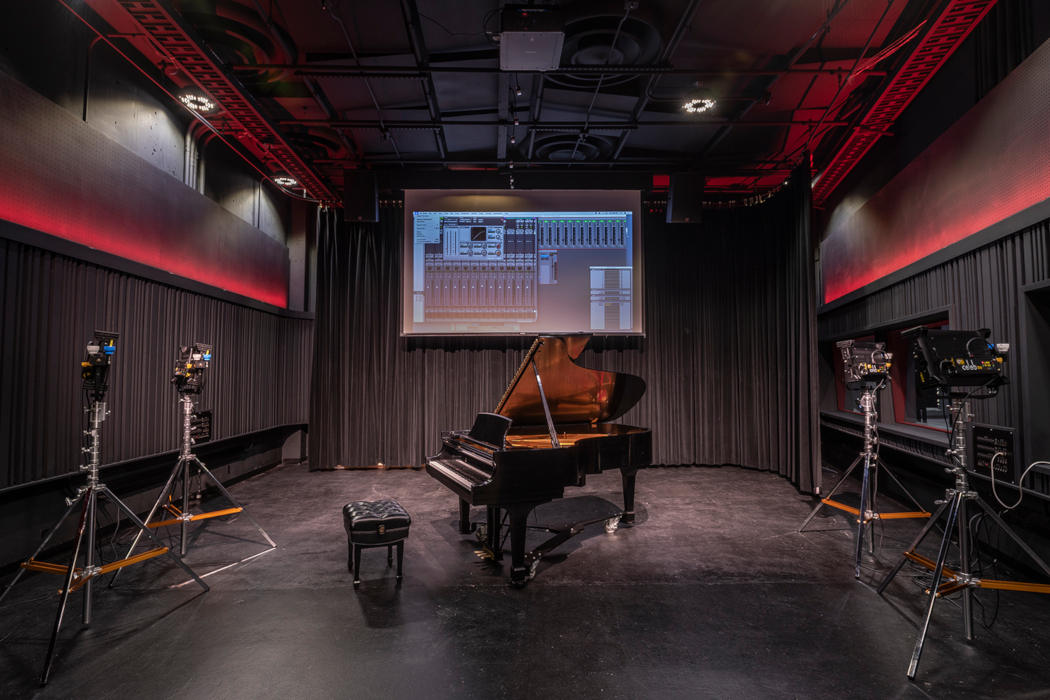
Use of the NDI protocol is a good example of how the designer’s choices can affect the future, as the flexible protocol makes it possible easily to increase (or decrease) the number of video sources available for live production switching, without directly attaching to devices, changing locations or having to invest in expensive, high-bandwidth networks.
For audio and video connectivity in the studio, the team installed five custom microphone and video connection panels at key points in the room, along with an instructor wall panel and instructor touchpanel controller from Extron. For presenter connectivity, the company’s DTP T UWP 4K 232 D wallplate provides a two-input DTP transmitter for HDMI and VGA signals with audio embedding. For controlling presentations, Extron’s TLP Pro 725T seven-inch tabletop TouchLink Pro touchpanel features a capacitive Gorilla Glass touchscreen with 1024×600 resolution and 24-bit color, quad-core processing, PoE and a built-in speaker.
A Canon REALiS 4K501ST LCOS 5,000-lumen projector with 4096×2400 resolution was mounted on the grid with Chief mounting hardware, along with an Extron scaling receiver. To stay within budget, HD Progressive 1.1 replacement screen material was installed into an existing Da-Lite 165-inch diagonal screen with a standard 16:9 aspect ratio.
Immersive Audio Control Room
Although the original wall between the 300-square-foot control room and production studio would remain, the new design called for entryways to be reworked and new glass installed between the studio and control room spaces to provide better isolation. Engineering teams that implemented the new design included mechanical engineer Marcy Ramos and electrical engineer Mike Meyers of Albany NY’s Sage Engineering, with construction implemented by Albany-based contractors Uwe Kiss and John Moore of Sano Rubin Construction Services, LLC.
Elliot-Brown specified Avid Pro Tools S6 as the primary recording system for the HASS Media Studio. She described the audio control room is an “in-the-box” system using an Avid S6 controller with a Pro Tools system that utilizes MTRX and ANDIAMO I/Os. The system can be used to record locally in the production studio, as well as to experiment with non-standard surround speaker configurations. The MTRX is Dante-enabled and incorporates a 1500×1500 matrix switcher that can be used to route audio signals, via Dante, to and from the EMPAC over the dedicated single-mode fiber connections between the two facilities. The Dante connection enables the HASS Media Studio to use any of the studios or performance spaces in EMPAC as recording rooms for larger ensembles. Dante connectivity to and from the studio over the RPI LAN can also be used to capture special events occurring anywhere on campus.
The S6 M40 modular control surface for RPI provided 16 faders, 16 channels of five configurable knobs, 16 channels of process modules, 16 channels of displays and a common center section. The M40 features a tilting 12.1-inch multipoint touchscreen, eight adjacent rotary encoders, and dedicated knobs and keys for monitoring and global control. Among the M40’s most interesting features is its integration with software tools, like Dolby Atmos, which support cutting-edge, immersive, 3D audio, including software for advanced control of audio objects.
Moving past the AC-3 5.1 audio standard that has been in practice for more than 15 years, digital audio tools like Avid’s S6 support mixing immersive audio. Immersive audio adds ceiling speakers to provide a 360-degree audio experience. Different approaches to immersive audio trade channel assignments for a set of audio vectors that can be combined into whatever speaker configuration is desirable at the moment. Then, audio can be reproduced so that sound effects can be localized to positions relative to each listener. Defined as audio objects, immersive sounds can be static or dynamic, and, thus, panned around the theater space. This technology turns creative effects into ultra-real audio sensory experiences.
To facilitate hands-on control of immersive sound mixes, Elliot-Brown’s design for the S6 system called for the addition of an S6 master joystick module. The joystick module enables mix engineers to position sounds anywhere within a room, without having to look away from the big screen. A 3.2-inch thin-film transistor (TFT) display on the unit shows current pan and joystick locations, whereas four OLED displays provide detailed visual feedback. The module also features two multicolor LED top-lit encoders, 16 panning mode switches with color LEDs and other panning control switches for precisely controlling positioning and divergence. The joystick module can also be set up to control any other knob parameter on S6 to create a wide range of effects.
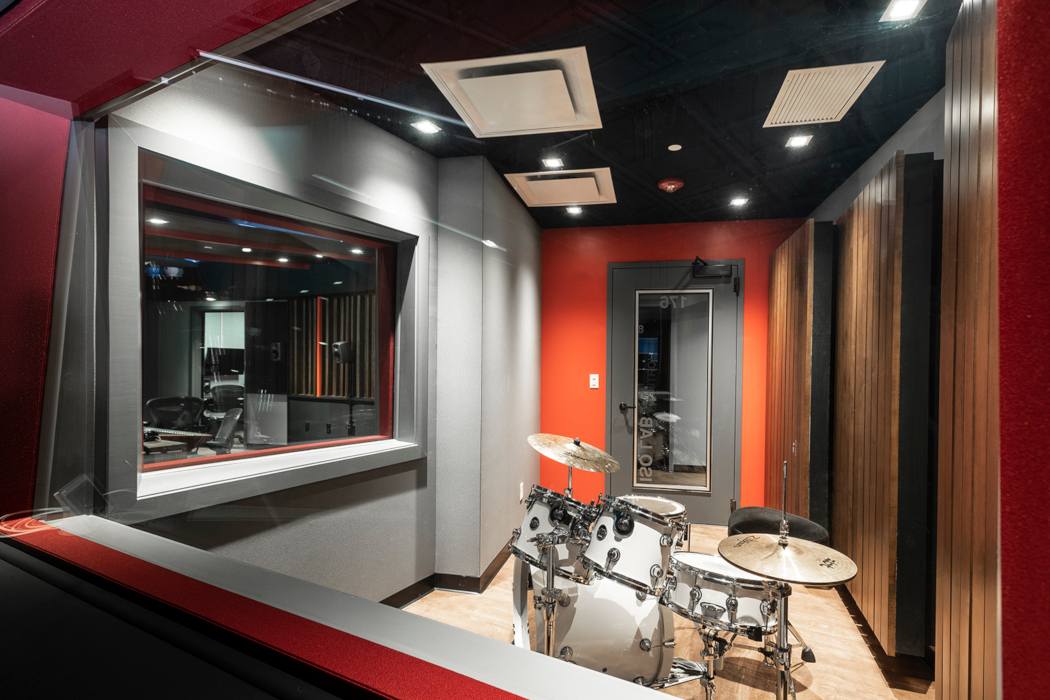
The S6 control gear for the audio control room was installed into a producer’s desk designed by Sterling Modular that is flanked by two Nice-Racks 16RU equipment racks for outboard gear. The project added a 256GB Apple 10.5-inch iPad Pro (with Wi-Fi and cellular) for remote app controls and studio operation, along with an Audio-Technica AT808G dynamic subcardioid gooseneck microphone and a Rolls MP13 mini microphone preamp for the S6 console talkback system. A DirectOut ANDIAMO 2 AD/DA MADI converter provides the monitor interface for the S6.
For traditional audio mixing, two Focal Trio6 Be loudspeakers were chosen as mains for the control room for their extreme neutrality and precise stereophonic imaging. Installed on Sound Anchor ADJ2 speaker stands, the Trio6 Be is a three-way speaker with a one-inch tweeter, a five-inch woofer and an eight-inch subwoofer self-powered with Class G amplifiers.
In addition to the control room mains, eight Genelec 8030Cs installed in the control room make the space suitable for mixing and experimenting with immersive audio. Speakers associated with left, right and center channels sit on the Sterling Modular desk, with the five remaining speakers mounted to the walls with Genelec 8000-422B mounts. A Genelec 7050B subwoofer provides the lower frequencies required for effective 5.1, 7.1 and 8.2 audio. Playback systems were tuned by WSDG engineer Andy Swerdlow.
A Samsung DC55E 55-inch direct-lit LED display mounted with a Sanus VLT5 wall-mount works as the large display for the audio studio with an Extron DTP HDMI 4K 230 Rx DTP receiver for HDMI. Control for the large display is accomplished with an Extron EBP-100 simple remote, a push-button panel that is located on the producer’s desk and a Blackmagic Design Videohub Master Control.
Networked Video Control Room
WSDG’s specifications for the HASS Media Studio’s 160-square-foot video control room enable state-of-the-art video production using NewTek’s TriCaster TC1 SP control surface and TC1 R3 video switcher. The video control room is a completely networked system based on NDI video. The “switcher” control panel, the engine and additional I/O devices are interconnected via a network switch. The TC-1 accepts both SDI video and NDI (Cat6 video-over-IP) inputs and outputs to SDI, NDI or directly to the internet. Multiviewer output for the Tri-Caster is handled by two Samsung MU8000 49-inch LED displays mounted with Gabor TM-3770 tilting wall mounts and connected with DisplayPort to HDMI adapters.
The video system was designed to be used locally for teaching four-camera shoots, as well as to capture live performances in the production studio. A Blackmagic Design Smart Videohub acts as a 40×40 SDI router, connecting the studio cameras, Ki Pro Ultra Plus recorder, production studio projector, audio control room, etc., to the TC-1. The EMPAC SDI video system (over fiber) provides video to and from the HASS Media Studio when the studios or performance spaces in EMPAC are being used as recording rooms. NDI connectivity to and from the studio over the RPI LAN can also be used to capture special events on campus.
Additionally, students can use the TriCaster system to learn about multi-channel ISO recording to full-resolution QuickTime and H.264 files for video-on-demand, dual-channel live streaming to Facebook Live, Microsoft Azure, Periscope, Twitch, YouTube Live and other services. The system even provides real-time social-media sharing and studio-grade Skype video calling. A 2.5GHz Quad-core Intel Core i7 Apple Mac Pro with 16GB of synchronous dynamic random access memory (SDRAM), 512GB PCIe-based flash storage and a Dell S2715H 27-inch display was added in the video suite for handling graphics. The AJA Ki Pro Ultra Plus video recorder was rackmounted on a Middle Atlantic 3RU shelf to provide up to four channels of simultaneous HD recording; in single-channel mode, the unit can operate as a 4K/ultra HD/2K/HD Apple ProRes, Avid DNxHR MXF for 4K/ultra HD, or Avid DNxHD MXF recorder and player. With support for large-raster, high-framerate workflows, up to 4K60p with high-dynamic-range (HDR) playout and recording, the unit supports 3G-SDI, fiber and full HDMI 2.0 digital video connectivity. An RDL RU-LB4 four-channel Dante I/O interface provides an audio interface for the TriCaster system.
To handle audio requirements in the video control room, the team installed a Mackie 1604VLZ4 16-channel, four-bus mixer and selected two Audio Accessories WEP-961E-SH 2×48 audio patchbays. Two Genelec 8030C powered speakers, which are mounted with Genelec 8000-422B wall mounts, provide great sound for video mixing and editing. To make control of routed video signals easy, a Blackmagic Designs icon-based Videohub control was added to provide local control for the studio’s shared SDI router. The pushbutton view allows engineers at the HASS Media Studio to control network resources dynamically by pressing images of common video equipment on a screen.
A Clear-Com production intercom system was added to facilitate video sessions consisting of Clear-Com’s KB-702 GM speaker station, two GM-9 microphones, a countertop V-BOX, a remote master station and an MA-704 four-port XLR-3 IFB intercom/audio cue breakout matrix interface.
The lighting control infrastructure for the production studio space was updated with new wiring from the rack room to the lighting grid, making both conventional DMX and DMX-over-Cat6 control possible. The existing dimmer-to-fixture lines were repurposed to carry 120V AC to the grid to power seven Elation KL Fresnel 6 and four Kino Flo Celeb 250 fixtures that were installed on the grid. A Pathway Connectivity Cognito2 lighting console was added, and it can be operated from the video control room, the production studio or the AV lab.
Speaking of the AV lab, plans for the HASS Media Studio included this space, which is intended for users with laptops who are working on individual projects and who have to monitor audio and video. The AV lab is equipped with a Focusrite Scarlett 2i4 192kHz/24-bit powered audio interface and two Neumann KH 120A desktop speakers, as well as a Samsung DC40E DC-E Series 40-inch direct-lit LED display.
Two Middle Atlantic MRK-4431LRD racks house all the processing gear for the HASS Media Studio, including specific units that support classroom activities; among those are an Extron DTP CrossPoint 84 4K IPCP SA scaling 4K presentation switcher, which provides the video for the audio control room’s large display and the production studio’s projectors. The Extron provides video to, and displays video from, the video control room systems via connections to the Blackmagic Design 40×40 SDI router. An RDL RU-LB2 two-channel line-level network interface delivers Dante I/O for the Extron switcher, and a Netgear ProSAFE 24-port fast Ethernet PoE smart managed switch supports the classroom’s touchpanel controller.
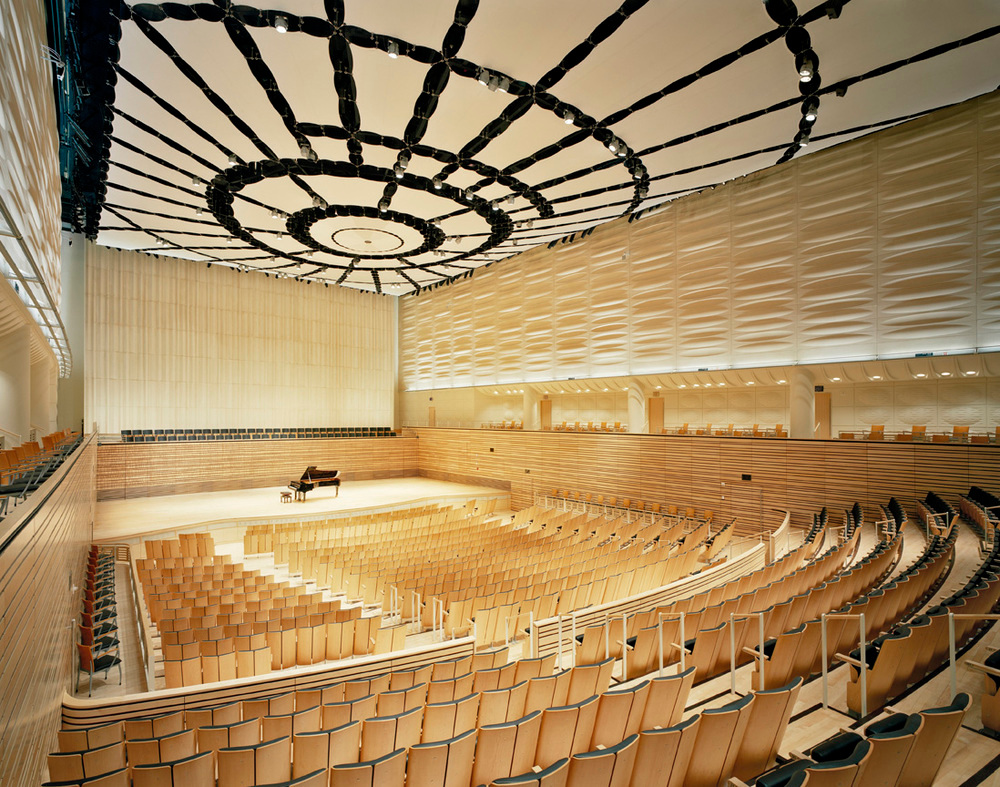
An Apple Mac Pro that runs OS X Sierra with an Intel Xeon E5 six-core processor and 12MB of L3 cache, 64GB 1866MHz DDR3 ECC and dual AMD FirePro D700 graphic processors, each with 6GB GDDR5 VRAM, was specified as the audio control room’s digital audio workstation (DAW). To meet RPI’s expectations that students should have exposure to a variety of popular audio software solutions, Avid ProTools HD 12, Steinberg Nuendo 8 and Apple Logic Pro X software have been installed in the Mac Pro, along with Audinate Dante Virtual Soundcard software that supports connectivity to Dante sources. A Magma ExpressBox 3T Thunderbolt expansion chassis for the Avid HDX cards was added to the Mac Pro, and the analog audio I/O for the DAW is provided by an Avid MTRX with the Dante option and five Avid MTRX 8 pristine mic/line A/D cards.
A Cisco Small Business 200 Series SLM2008T network switch was installed to give the studio a Eucon network for S6 DAW control. An Xilica XP-4080 audio processor supports the control room mains and subs, while the same manufacturer’s XP-8080 unit processes signals for the 8.0 audio system. An Aviom D800-Dante A-Net distributor with A-Net bridge input for Dante was installed as a “self-mix” cue system, and a secondary stereo cue system is powered by an Ashly KLR-2000 amplifier.
Two Cisco SG350X-24MP routers act as primary and secondary Dante switches, with four Cisco MGBLH1 gigabit LH Mini-GBIC SFP transceivers installed. A portable Focusrite AM-2 Dante audio monitor was provided for monitoring Dante traffic on the networks. A NewTek TriCaster NC1 studio I/O module presents video switcher signals for an SG350X-24MP, with two MGBLH1s assigned to the studio’s NDI switch. Clocking and synchronization for the studio is accomplished with an ESE LX- 220A black-burst generator/master clock, and distribution is handled with an ESE ES-247E quad 1×6 video distribution amplifier that provides four independent 1×6 video DAs in a single rackmount enclosure.
The new HASS Media Studio, a result of an educator’s vision, along with the design and project-management expertise of a motivated WSDG team, will be providing important experiences for RPI’s students and faculty for many years to come.
“We know that the studio will be popular,” Osburn affirmed. “We’ve looked at similar programs around the country to determine the best way to prioritize time in the studio, balancing individual needs with what is possible and what make the most sense.” Ultimately, the school must find ways to support both student needs and faculty needs, while also leaving time to experiment with the powerful connectivity offered by the campus’ fiber network, which connects the studio to performance and research spaces across the school’s campus.
For leading engineering institutions like RPI, the convergence of AVL and IT technologies, including the campus network infrastructure, has created powerful environments for both teaching and research. In addition to deploying these technologies in traditional studio and production settings, using media in experimental ways is important for research-driven schools; doing so not only prepares students for what they might encounter after graduation, but also helps to ensure new discoveries. The effect that such a technology-rich environment has on students is exhilarating.
Simoni concluded, “Bringing together brilliant faculty and students in a shared production environment like the HASS Media Studio inspires us to work collaboratively first to imagine, and then to invent, the next generation of media integration.”
Equipment
Production Studio
1 Canon REALiS 4K501ST LCOS projector
1 Chief 4K projector mounting hardware
1 Da-Lite 165″ diagonal screen w/16:9 aspect ratio
7 Elation KL Fresnel 6 150W 3000K 97CRI warm white LED fresnels
1 Extron DTP HDMI 4K 330 Rx long-distance, digital twisted-pair receiver
1 Extron DTP T UWP 4K 332 D 2-input, decorator-style transmitter
1 Extron TLP Pro 725T 7″ tabletop TouchLink Pro touchpanel
4 Kino Flo Celeb 250 DMX LED fixtures w/centermount kits w/flight cases
2 Martin Audio CDD-LIVE 15 self-powered, 2-way systems
1 NewTek NDIHX-PTZ1 NDI PTZ camera
Audio Control Room
1 Apple 10.5″ iPad Pro (256Gb)
1 Audio-Technica AT808G subcardioid dynamic console mic
1 Avid S6 M40 control surface (16 faders)
1 Avid S6 master joystick module
1 Blackmagic Design Videohub Master Control
1 Clear-Com GM-9 9″ plug-in gooseneck mic
1 Clear-Com KB-702GM 2-channel select flush-mount speaker station
1 Clear-Com V-BOX wedge-shaped enclosure
1 DirectOut ANDIAMO 2 AD/DA MADI converter
1 Extron DTP HDMI 4K 230 Rx digital twisted-pair receiver
1 Extron DTP T UWP 4K 332 D 2-input, decorator-style transmitter
1 Extron EBP 100 eBUS button panel w/6 buttons
1 Extron SMB 112 2-gang surface-mount box (black)
2 Focal Trio6 Be 8″ powered studio monitors
1 Genelec 7050B studio sub
5 Genelec 8000-422B wall mounts w/T-plates
8 Genelec 8030C 5″ powered studio monitors
2 Nice-Racks 16RU wood panels, rack rail front and rear
1 Rolls MP13 mini mic preamp
1 Samsung DC55E DC-E Series 55″ direct-lit LED display
1 Sanus Premium Series VLT5 tilt mount
2 Sound Anchor ADJ2 44″ tall monitor stands
Video Control Room
1 AJA Ki Pro Ultra Plus multi-channel Apple ProRes recorder
1 Apple Mac Pro
2 Audio Accessories WEP-961E-SH audio patchbays
1 Blackmagic Design Videohub Master Control
1 Cisco Small Business 200 Series SLM2008TNA smart SG200-08 gigabit Ethernet switch
2 Clear-Com GM-9 9″ plug-in gooseneck mics
1 Clear-Com KB-702GM 2-channel select flush-mount speaker station
1 Clear-Com MA-704 Encore IFB control panel w/mic jack
1 Clear-Com RM-702 Encore 2-channel headset station
1 Clear-Com V-BOX wedge-shaped enclosure
1 Dell S2715H 27″-screen LED-lit monitor
1 Elation OPTO BRANCH 8 19″, single-rackspace, 8-way DMX distributor/booster
2 Gabor TM-3770 tilting wall mounts
2 Genelec 8000-422B wall mounts w/T-plates
2 Genelec 8030C 5″ powered studio monitors
2 HP EliteDisplay E230t 23″ touch monitors
1 Mackie 1604VLZ4 16-channel, 4-bus mixer
1 Middle Atlantic 3RU shelf
1 NewTek TriCaster TC1 R3 video switcher
1 NewTek TriCaster TC1 SP control surface
1 Pathway Connectivity Cognito2 lighting console
1 RDL RU-LB4 line-level bi-directional network interface
2 Samsung UN49MU8000FXZA 49″ MU8000 premium 4K ultra-HD TVs
AV Lab
1 Chief tilting wall mount
1 Focusrite Scarlett 2i4 2nd generation USB audio interface
2 Neumann KH 120-A studio monitors
1 Samsung LH40DCEPLGA/GO DC40E direct-lit LED display
Equipment Racks
1 Apple Logic Pro X
1 Apple Mac Pro/OS X Sierra/Intel Xeon E5 6-core processor
1 Ashly KLR-2000 stereo power amp
1 Audinate Dante Virtual Soundcard software
1 Avid MTRX w/Dante option
5 Avid MTRX 8-line pristine AD cards (8 analog inputs)
1 Avid Pro Tools HD 12 software (perpetual license)
1 Avid Pro Tools HDX core card
1 Aviom D800-Dante A-Net distributor
1 Blackmagic Design HDMI-4K-to-SDI mini converter
1 Blackmagic Design SDI-to-HDMI-4K mini converter
1 Blackmagic Design Smart Videohub 40×40 6GSDI mixed-format router
4 Cisco MGBLH1 gigabit LH Mini-GBIC SFP transceivers
2 Cisco SG350X-24MP 24-port gigabit PoE stackable managed switches
1 Cisco Small Business 200 Series SLM2008TNA smart SG200-08 gigabit Ethernet switch
1 ESE ES-247E quad 1×6 video distribution amp
1 ESE LX-220A RS-170A black-burst generator/enhanced circuitry
1 Extron DTP CrossPoint 84 4K IPCP SA stereo amp
1 Extron DTP HDMI 4K 230 Tx DTP transmitter for HDMI
1 Focusrite RedNet AM2 stereo Dante headphone amp
1 Magma ExpressBox 3T Thunderbolt expansion chassis
2 Middle Atlantic MRK-4431 LRD MRK Series racks, 44RU, 31″D, w/o rear doors
1 Netgear ProSAFE 24-port gigabit smart managed switch
1 NewTek TriCaster NC1 8-channel I/O module
1 RDL RU-LB2 line-level bi-directional network interface
1 Steinberg Nuendo 8 post-production audio workstation software
1 Xilica XP-4080 4-input/8-output, fixed-architecture digital audio system processor
1 Xilica XP-8080 8-input/8-output, fixed-architecture digital audio system processor
List is edited from information from WSDG.
